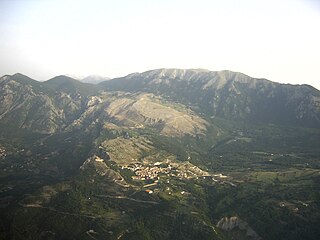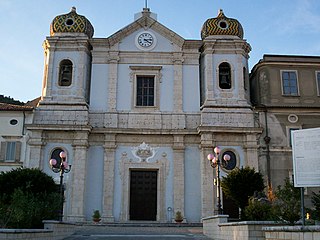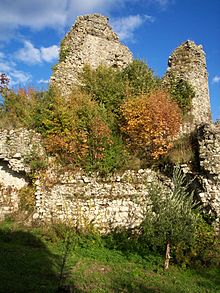
Benevento is a city and comune (municipality) of Campania, Italy, capital of the province of Benevento, 50 kilometres (31 mi) northeast of Naples. It is situated on a hill 130 metres above sea level at the confluence of the Calore Irpino and the Sabato. In 2020, Benevento has 58,418 inhabitants. It is also the seat of a Catholic archbishop.

Guardia Sanframondi is a town and comune in the Province of Benevento, in Campania region, in Italy. It is best known for its wine production, the wine festival Vinalia and for its Christian penitential rite held every seven years.
San Lupo is the name of a hill town and comune in the province of Benevento, in the Campania region of southern Italy. It is a member of the Titerno "Local Action Group".

Cerreto Sannita is a comune (municipality) in the Province of Benevento in the Italian region Campania, located about 60 km northeast of Naples and about 25 km northwest of Benevento.

Cusano Mutri is a comune (municipality) in the Province of Benevento in the Italian region Campania, located about 60 km northeast of Naples and about 35 km northwest of Benevento.

Morcone is a comune (municipality) in the Province of Benevento in the Italian region Campania, located about 70 km northeast of Naples and about 25 km northwest of Benevento. The villages (Contrade) of Morcone include: Canepino, Cuffiano, Coste, Torre, Fuschi, Piana.

Pietraroja is a mountain comune (municipality) in the province of Benevento in Campania, southern Italy. It is approximately 50 km by car from Benevento, in direction north-west, 83 km from Naples in direction north-east and approximately 223 km from Rome in direction south-east.

San Lorenzello is a comune (municipality) in the Province of Benevento in the Italian region Campania, located northeast of Naples and about 25 kilometres (16 mi) northwest of Benevento.

The Diocese of Cerreto Sannita-Telese-Sant'Agata de' Goti is a Latin diocese of the Catholic Church in Campania, Italy, has existed since 1986, when the Diocese of Sant'Agata de' Goti was suppressed, and its territory and Catholic population united to the Diocese of Telese-Cerreto Sannita. The diocese is a suffragan of the Archdiocese of Benevento.

The 1980 Irpinia earthquake took place in Italy on 23 November 1980, with a moment magnitude of 6.9 and a maximum Mercalli intensity of X (Extreme). It left at least 2,483 people dead, at least 7,700 injured, and 250,000 homeless.
On 5 February AD 62, an earthquake of an estimated magnitude of between 5 and 6 and a maximum intensity of IX or X on the Mercalli scale struck the towns of Pompeii and Herculaneum, severely damaging them. The earthquake may have been a precursor to the eruption of Mount Vesuvius in AD 79, which destroyed the same two towns. The contemporary philosopher and dramatist Seneca the Younger wrote an account of the earthquake in the sixth book of his Naturales quaestiones, entitled De Terrae Motu.
The 1936 Cansiglio earthquake occurred on 18 October in the region between the provinces of Belluno, Treviso and Pordenone, in northern Italy. It caused 19 deaths and an unknown number of injuries.
The 1639 Amatrice earthquake occurred on 7 October near Amatrice, in the upper valley of the river Tronto, at the time part of the Kingdom of Naples, now Italy.
On December 5, 1456, the largest earthquake to occur on the Italian Peninsula in historical times struck the Kingdom of Naples. The earthquake had an estimated moment magnitude of Mw 7.19–7.4, and was centred near the town of Pontelandolfo in the present-day Province of Benevento, southern Italy. Earning a level of XI (Extreme) on the Modified Mercalli intensity scale, the earthquake caused widespread destruction in central and southern Italy. Estimates of the death toll range greatly with up to 70,000 deaths reported. It was followed by two strong Mw 7.0 and 6.0 earthquakes to the north on December 30. The earthquake sequence is considered the largest in Italian history, and one of the most studied.
A series of mainshocks struck Calabria on March 27–28 and June 9, 1638. The first three earthquakes had moment magnitudes estimated to be 6.6–7.1. On June 9, another mainshock estimated at Mw 6.7 struck the same region, causing further damage and casualties. The four earthquakes resulted in as many as 30,000 fatalities.
The 1743 Salento earthquake affected the Apulian region of southwestern Italy on 20 February at 23:30 IST. The ~7.1 Mw earthquake had an epicenter in the Adriatic and Ionian seas, off the coast of modern-day Lecce and Brindisi provinces in Salento. It had a maximum Modified Mercalli intensity of IX (Violent), causing heavy damage in Nardò. Damage was also reported across the sea, in the Balkans. The earthquake also generated a tsunami of up to 11 meters in run-up. Between 180 and 300 people were killed in the disaster.

The former Monastery of the Poor Clares of Cerreto Sannita is an ancient place of worship founded in 1369 by Francesca Sanframondi, collateral relative and chamberlain to Queen Joanna I of Naples as well as a relative of Giovanni III Sanframondi, count of Cerreto Sannita. Rebuilt after the June 5, 1688 earthquake, the monastery housed the order of Urbanist Poor Clares from the 14th century to the 20th century when it became the property of the Sisters of Charity of Our Lady of Good and Perpetual Help, who established a boarding school, kindergarten, language high school, school and teacher training institute there, naming the complex after Pope Leo XIII. The church attached to the monastery is a splendid example of Baroque architecture. Remained intact over the centuries, it preserves in the pronaos an 18th-century ceramic floor.

The collegiate church of San Martino is a religious building located in the historic center of Cerreto Sannita.
The history of Cerreto Sannita includes a series of events that have affected the town's territory since the Neolithic age. The old Cerreto, built following the Saracen invasions and destroyed by the earthquake of June 5, 1688, was later replaced by the present Cerreto Sannita, built between 1688 and 1696 to the design of royal engineer Giovanni Battista Manni and at the behest of Count Marzio Carafa, his brother Marino Carafa and Bishop Giovanni Battista de Bellis. An episcopal see since the 16th century, it was a fief of the Sanframondo family from 1151 to 1460, later becoming a possession of the Carafa family. Flourishing wealth from industries and the wool cloth trade helped create a strong merchant class capable of resisting for centuries the constant abuse perpetrated by the feudal lords.













